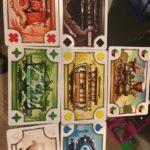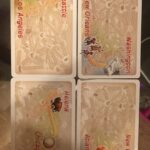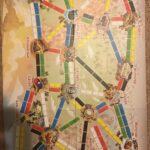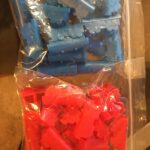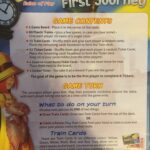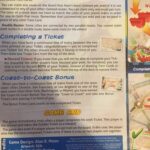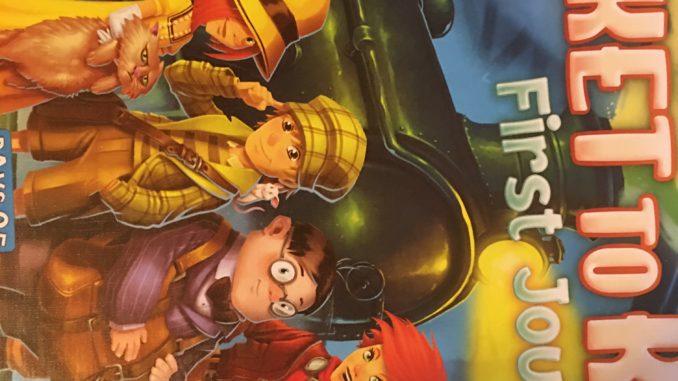

Game Summary
My First Journey is a scaled back version of the popular Ticket to Ride game. Ticket to ride was created by Alan Moon, and is designed in the mold of German-style board games (or Euro-style). While these games can have human interaction, that interaction is often more indirect than American style games. They are not typically considered “party games” like Trivial Pursuit or Cards Against Humanity. Instead, they require more in-depth thinking (note: this is why I like My First Journey, because it still requires critical thinking and planning but is straightforward enough to be enjoyed by my 7-year-old).
In My First Journey, you are racing to be the first player to complete six train routes in America. Each route connects well-known American cities. Players can also claim credit for a route if they build tracks that stretch all the way across the United States (called “coast to coast”).
Players turns are simplified in that you can only do one of three actions: 1) draw two cards, 2) place trains on the board (claiming a route), or 3) discard your two route cards in order to get new routes. More detailed rule explanations below.
The game is marketed as being for 6+, and the BoardGameGeek community seems to agree with that assessment. My current 7-year old loves playing the game, and initially learned it a few months prior to her seventh birthday.
Number of Players: 2-4 (while I enjoy the time spent with my daughter playing with the just the two of us, I find it more enjoyable when the wife or my niece joins in for at least three of us).
Time to Play: I’ve seen this listed as up to 30 minutes, but my experience is that most games are completed within 15-20 minutes; particularly once everyone knows exactly how to play.
Game Publisher: Days of Wonder (I suggest checking out their other games on Amazon!)
Game Contents
The game includes the following:
- 1 game board
- 80 plastic trains (plus a few extras of each color)
- 72 train cards
- 32 ticket cards
- 4 coast-to-coast bonus ticket cards
- 1 golden ticket
Key Concepts
Plastic Trains: You play these on the game board; each player has 20.
Train Cards: In order to claim a route, you must have the appropriate number of these that match the route (e.g., 3 blues or 2 greens)
Ticket Cards: These represent the tickets you are trying to complete (e.g., New York to Winnepeg)
Coast-to-Coast Cards: These are bonus tickets a player can earn by having routes that connect the east coast to the west coast
Golden Ticket: A fun add-on that the winning player earns; has not impact on the game
Claiming a Route: Occurs when a player plays train cards that match a route on the game board (e.g., New York to Washington requires a yellow train card or a blue train card)
Completing a Ticket: This happens when a player builds a continuous line of trains between two cities represented on one of their two Ticket Cards
Double Routes: Some cities have two routes connecting them; these are called double routes (and no player may claim both routes; stop being selfish!)
Game Setup
Starting the game requires:
- Placing the game board so all players can reach
- Giving each player 20 trains of their chosen color
- Dealing 4 train cards to each player; remaining train cards should be placed somewhere easy for each player to draw from
- Dealing 2 ticket cards to each player; if convenient, make it easy for each player to reach but not as important as the train cards
Ticket to Ride: My First Journey Rules
The youngest player goes first (which means I always go last in my household!). Play progresses clockwise.
On a turn, players have three options:
- Draw two train cards
- Claim a route
- Discard both ticket cards in order to draw two new ones (used primarily if your path is blocked late in the gam)
Claiming a route
As mentioned before, claiming a route involves playing train cards that match a route on the game board. To use the same example: claiming a route between Washington and New York would require a player to play either a yellow train card or a blue train card (not both!). Once a player does this, they place one of their plastic trains on the appropriate place (in this case, the yellow or blue rectangle).
You discard the played train cards faceup beside the train deck. These can be re-shuffled in the deck runs out during the game.
You can claim any route you want as long as you have the appropriate number and color train cards.
You may only claim one route per turn.
Locomotives (wild cards) can represent any color.
Completing a Ticket
Once you build a continuous line of trains between the cities on one of your two ticket cards, you have completed a ticket. Once done, you:
- announce to the other players you have completed a ticket
- flip the ticket card faceup in front of you
- draw a new ticket card
- do a happy dance (optional)
Winning the game
The game immediately ends when a player claims their sixth ticket (either 6 ticket cards, or 5 ticket cards + 1 coast-to-coast card).
The game can also end if a player places their last train on the board. The winner in that case is whoever has the most tickets (which could result in a tie).
Common Questions
What happens when you run out of trains?
The game ends when any player runs out of their 20 trains. The player, or players, who have the most completed tickets so far wins the game. For this reason, it can be a late-game strategy to run yourself out of trains if you know you are ahead in the total number of completed tickets.
How do I claim a coast-to-coast card?
Once you have a continuous line of trains connecting the east coast (Miami, Washington DC, New York) to the west coast (Seattle, San Francisco, Los Angeles), you just need to announce to the other players that you have completed the coast-to-coast ticket. Make sure you add a coast-to-coast ticket card to your other completed tickets to count towards your 6-ticket goal.
Can a player receive more than one coast-to-coast card?
No. Each player can only earn one coast-to-coast card in a game.
What happens if I draw a ticket card and already have a continuous line of trains connecting the two cities?
Congratulations! You can immediately announce you have completed the ticket and draw a new card. This happened to my daughter in our last game. Needless to say, she was quite happy and won the game on the spot!
Game Strategy/Tips
1. You do not have to claim a just because you have the cards to match it. Sometimes a route does help you complete a ticket. And sometimes it would require you to use a wild card that you may be better off saving. I’ve had success holding my wild cards, but have also been penalized by never drawing the color(s) train cards I needed.
2. I don’t find it advantageous to pursue routes that are directly connected to me completing a ticket. The only instance where this is not true is if I am trying to exhaust all of my trains in order to claim the alternate victory (having the most tickets when someone runs out of trains).
Where to Buy Ticket to Ride: My First Journey
I purchased our copy from Amazon, but you can also purchase from Target or Walmart.

